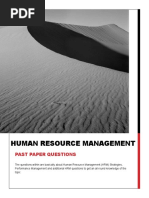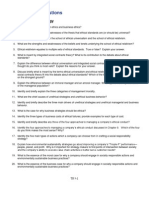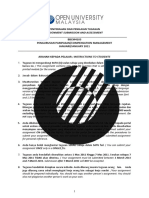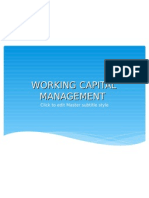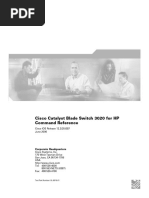0 ratings0% found this document useful (0 votes)
169 viewsT Q C 1: C C A: EST Uestions For Hapter Omparable Ompanies Nalysis
T Q C 1: C C A: EST Uestions For Hapter Omparable Ompanies Nalysis
Uploaded by
He HaoCopyright:
© All Rights Reserved
Available Formats
Download as PDF, TXT or read online from Scribd
T Q C 1: C C A: EST Uestions For Hapter Omparable Ompanies Nalysis
T Q C 1: C C A: EST Uestions For Hapter Omparable Ompanies Nalysis
Uploaded by
He Hao0 ratings0% found this document useful (0 votes)
169 views14 pagesOriginal Title
Untitled
Copyright
© © All Rights Reserved
Available Formats
PDF, TXT or read online from Scribd
Share this document
Did you find this document useful?
Is this content inappropriate?
Copyright:
© All Rights Reserved
Available Formats
Download as PDF, TXT or read online from Scribd
Download as pdf or txt
0 ratings0% found this document useful (0 votes)
169 views14 pagesT Q C 1: C C A: EST Uestions For Hapter Omparable Ompanies Nalysis
T Q C 1: C C A: EST Uestions For Hapter Omparable Ompanies Nalysis
Uploaded by
He HaoCopyright:
© All Rights Reserved
Available Formats
Download as PDF, TXT or read online from Scribd
Download as pdf or txt
You are on page 1of 14
TEST QUESTIONS FOR CHAPTER 1:
COMPARABLE COMPANIES ANALYSIS
1. What is the premise behind comparable companies analysis?
Explanation: Similar companies provide a highly relevant reference
point for valuing a given target due to the fact that they share
key business and financial characteristics, performance
drivers, and risks.
2. Select all that apply. What are some of the key business characteristics to
examine when screening for comparable companies?
a) Sector
b) Return on investment
c) End markets
d) Distribution channels
Answer: A, C, and D
3. Select all that apply. What are some of the key financial characteristics to
examine when screening for comparable companies?
a) Profitability
b) Growth profile
c) Customers
d) Credit profile
Answer: A, B, and D
4. Company A and Company B are peer companies in terms of business
characteristics, but they are currently trading at substantially
different multiples. What discrepancies in financial characteristics
could help explain this situation?
Explanation: Company A could have higher profit margins, higher
levels of projected growth, or less leverage; while Company
B could have experienced management turnover, missed
earnings estimates, or lost a major distributor.
Chapter 1_Comparable Companies Analysis_Q&A
5. Select all that apply. What is EBITDA and why it is useful for relative
comparison when using enterprise value trading multiples?
a) Earnings before insurance, taxes, depreciation and amortization
b) Earnings before interest, taxes, depreciation and amortization
c) It is free from differences resulting from capital structure, tax regime,
accounting policies, and capital spending
d) It is viewed as the earnings available to equity holders once all of the
company’s obligations have been satisfied
Answer: B and C
6. What are the two most generic and widely used valuation multiples?
a) Enterprise Value-to-EBITDA
b) Total Debt-to-EBITDA
c) Price-to-Earnings (P/E)
d) Equity Value-to-Cash Flow
Answer: A and C
7. Given the assumptions below, calculate fully diluted shares outstanding
using the Treasury Stock Method.
($ in millions, except per share data; shares in millions)
Assumptions
Current Share Price $40.00
Basic Shares Outstanding 200.0
Options Outstanding 10.0
Weighted Average Exercise Price $26.00
Answer:
($ in millions, except per share data; shares in millions)
Calculation of Fully Diluted Shares Using the TSM
Options Proceeds (10.0 x $26.00) $260.0
/ Current Share Price $40.00
Shares Repurchased from Option Proceeds ($260.0 / $40.00) 6.5
Shares from In-the-Money Options 10.0
Less: Shares Repurchased from Option Proceeds (6.5)
Net New Shares from Options (5.0 – 4.5) 3.5
Plus: Basic Shares Outstanding 200.0
Fully Diluted Shares Outstanding (100 + 0.5) 203.5
Chapter 1_Comparable Companies Analysis_Q&A
8. If a company has an enterprise value of $1,000 million and equity value
of $1,150 million, what is the company’s net debt?
a) $250 million
b) ($250) million
c) $150 million
d) ($150) million
Answer: D
9. Given the assumptions below, calculate equity value and enterprise
value.
($ in millions, except per share data; shares in millions)
Assumptions
Current Share Price $20.00
Fully Diluted Shares Outstanding 50.0
Total Debt 250.0
Preferred Stock 25.0
Noncontrolling Interest 15.0
Cash and Cash Equivalents 50.0
Explanation:
($ in millions, except per share data; shares in millions)
Calculation of Equity Value and Enterprise Value
Current Share Price $20.00
Fully Diluted Shares Outstanding 50.0
Equity Value $1,000.0
Plus: Total Debt 250.0
Plus: Preferred Stock 35.0
Plus: Noncontrolling Interest 15.0
Less: Cash and Cash Equivalents (50.0)
Enterprise Value $1,250.0
10. Given the information below, calculate LTM sales.
($ in millions)
Sales
FYE 12/31/07 $750.0
YTD 9/30/07 600.0
YTD 9/30/08 850.0
Explanation: $750 + 850 – 600 = $1,000
Chapter 1_Comparable Companies Analysis_Q&A
11. Given the information below, calculate CY12/31/2008E sales.
($ in millions)
Sales
FYE 4/30/2008A $1,000.0
FYE 4/30/2009E 1,150.0
Answer: ($1,000 x 4/12) + ($1,150 x 8/12) = $1,100
12. Which of the following would be typical non-recurring charges?
a) Losses on asset sales
b) Severance from restructuring
c) Inventory write-offs
d) Favorable litigation settlements
Answer: A, B, and C
13. Which of the following would be typical non-recurring benefits?
a) Goodwill impairment
b) Gains from asset sales
c) Facility closure
d) Favorable litigation settlements
Answer: B and D
Chapter 1_Comparable Companies Analysis_Q&A
14. Given the 2007 income statement data and non-recurring items below,
calculate adjusted EBITDA and net income.
($ in millions)
Income Statement
Reported Adjustments Adjusted
2007 + – 2007
Sales $1,000.0
Cost of Goods Sold 625.0
Gross Profit $375.0
Selling, General & Administrative 230.0
Restructuring Charges 10.0
Operating Income (EBIT) $135.0
Interest Expense 35.0
Pre-tax Income $100.0
Income Taxes @ 40% 40.0
Net Income $60.0
Operating Income (EBIT) $135.0
Depreciation & Amortization 50.0
EBITDA $185.0
Non-recurring items:
$5.0 million pre-tax inventory write-down
$10.0 million pre-tax restructuring charge
Explanation:
($ in millions)
Income Statement
Reported Adjustments Adjusted
2007 + – 2007
Sales $1,000.0 $1,000.0
Cost of Goods Sold 625.0 (5.0) 620.0
Gross Profit $375.0 $380.0
Selling, General & Administrative 230.0 230.0
Restructuring Charges 10.0 (10.0) -
Operating Income (EBIT) $135.0 $150.0
Interest Expense 35.0 35.0
Pre-tax Income $100.0 $115.0
Income Taxes @ 40% 40.0 6.0 46.0
Net Income $60.0 $69.0
Operating Income (EBIT) $135.0 15.0 $150.0
Depreciation & Amortization 50.0 50.0
EBITDA $185.0 $200.0
Chapter 1_Comparable Companies Analysis_Q&A
15. Using the calculations performed in questions #9 and #14, calculate the
2007 equity value and enterprise value multiples.
Explanation:
Equity Value-to-Net Income = $1,000 million / $69 million = 14.5x
Enterprise Value-to-EBITDA = $1,250 / $200 million = 6.25x
16. Given a 7.0x to 8.0x 2008E EV/EBITDA multiple range and 2008E
EBITDA of $250 million, calculate an implied enterprise value
range.
Explanation: $1,750 million to $2,000 million
17. Higher multiples are typically driven by what characteristics?
Explanation: Growth profile, and, potentially, margins and size.
18. All else being equal, which company would be expected to trade at a
higher multiple—a heavily leveraged company or one with moderate
to low leverage? Why?
Explanation: Moderate to low leverage. Such a company has a lower
risk of financial distress, coupled with a greater ability to
grow both organically and through acquisitions.
19. Why are forward-year multiples typically preferred to LTM multiples in
comparable companies?
Explanation: Investors are more focused on earnings potential than
historical earnings.
20. When would an NFY+1 multiple be used in lieu of an NFY multiple?
Explanation: In the event that investors are more focused on
earnings two years in the future, which may be more
indicative of normalized earnings, (e.g., for cyclical
companies that are perceived to be at a trough or peak).
21. A “Ba1” rating would be a _________ rating by _________.
a) Investment grade, Moody’s
b) Non-investment grade, Moody’s
c) Investment grade, S&P
d) Non-investment grade, S&P
Answer: B
Chapter 1_Comparable Companies Analysis_Q&A
22. The equivalent rating to Ba1 is:
a) BB
b) BB+
c) Baa1
d) B
Answer: B
23. Why are comparable companies sometimes tiered into different groups?
Explanation: Certain sub-groups are typically more appropriate than
the entire universe for framing valuation (e.g., based on
business model, size, and geography). This tiering requires a
sufficient number of comparable companies to justify
categorization.
24. Select ALL that apply. Assuming the need to start from scratch, what
are the best sources for locating comparable companies for a given
public company?
a) 10-K
b) Equity research reports
c) Fairness opinions for comparable companies—taken from proxy
statements for recently consummated M&A transactions in the
sector
d) 14D-9
Answer: A, B, and C
25. Match the following SEC forms to their names:
10-K Current report
10-Q Annual report
8-K Quarterly report
DEF14A Proxy statement
Answer:
10-K Annual report
10-Q Quarterly report
8-K Current report
DEF14A Proxy statement
Chapter 1_Comparable Companies Analysis_Q&A
26. What is an “initiating coverage” research report? Why is it important?
Explanation: Research report that is published when a research
analyst begins covering a given company. It tends to be more
comprehensive than normal interim reports. As a result, it is
beneficial to mine this report for financial, market, and
competitive insights.
27. What are First Call and IBES?
Explanation: First Call and IBES provide consensus analyst
estimates for earnings for thousands of publicly-traded
companies. They are the two most common sources used by
the banker for consensus estimates.
28. Why is it important to carefully analyze the individual analyst estimates
within consensus estimates?
Explanation: Certain estimates may be obsolete or not meaningful if
they haven’t been updated for recent announcements,
earnings guidance, or M&A transactions.
29. Why is it important to use companies’ earnings releases prior to the
filing of 10-Qs?
Explanation: Earnings releases are typically released in advance of
the corresponding 10-Q filing and contain sufficient
information to update comparable companies. Certain cash
flow statement data such as D&A, however, may require
waiting for the 10-Q.
30. Why is the share price as a percentage of the 52-week high an important
indicator?
Explanation: It is important for insight on sector trends as well as
relative performance vs. peers.
31. For spreading a comparable company’s financial data, where is D&A
typically sourced?
Explanation: The cash flow statement, and, in some cases, it is
shown on the income statement as a separate line item.
32. Is EBITDA typically reported as a line item on a company’s income
statement in an SEC filing? Explain.
Explanation: No. While it may be disclosed in a footnote or
supplemental materials, EBITDA is a non-GAAP financial
statistic. Therefore, it typically needs to be calculated (e.g.,
EBIT + D&A).
Chapter 1_Comparable Companies Analysis_Q&A
33. Where is a company’s most recent basic shares outstanding count
typically sourced?
Explanation: 10-K, 10-Q, or proxy statement, whichever is most
recent.
34. Given the following assumptions, calculate net new shares implied by
the convert, using the if-converted method.
($ in millions, except per share data; shares in millions)
Assumptions
Current Share Price $30.00
Convert Amount Outstanding $225.0
Conversion Price $22.50
Explanation:
($ in millions, except per share data; shares in millions)
If-Converted
Amount Outstanding $225.0
/ Conversion Price $22.50
Incremental Shares 10.0
Chapter 1_Comparable Companies Analysis_Q&A
35. Given the following assumptions, calculate net new shares from
conversion, using Net Share Settlement.
($ in millions, except per share data; shares in millions)
Assumptions
Current Share Price $30.00
Convert Amount Outstanding $225.0
Conversion Price $22.50
Explanation:
($ in millions, except per share data; shares in millions)
Net Share Settlement
Amount Outstanding $225.0
/ Conversion Price $22.50
Incremental Shares 10.0
x Current Share Price $30.00
Total Value of Convert $300.0
Less: Par Value of Amount Outstanding (225.0)
Excess Over Par Value $75.0
/ Current Share Price $30.00
Incremental Shares 2.5
36. Why is enterprise value considered capital structure neutral?
Explanation: Excluding fees and expenses, changes in a company’s
capital structure do not affect its enterprise value. For
example, if a company raises additional debt that is held on
the balance sheet as cash, its enterprise value remains
constant as the new debt is offset by the increase in cash (i.e.,
net debt remains the same).
Chapter 1_Comparable Companies Analysis_Q&A
37. Given the enterprise value calculation below, show the necessary
adjustments and pro forma amounts if the company issues $100.0
million of equity and uses the proceeds to repay debt.
($ in millions)
Actual Adjustments Pro forma
2007 + - 2007
Equity Value $1,000.0
Plus: Total Debt 250.0
Plus: Preferred Stock 50.0
Plus: Noncontrolling Interest 25.0
Less: Cash and Cash Equivalents (70.0)
Enterprise Value $1,250.0
Explanation:
($ in millions)
Actual Adjustments Pro forma
2007 + - 2007
Equity Value $1,000.0 100.0 $1,100.0
Plus: Total Debt 250.0 (100.0) 150.0
Plus: Preferred Stock 50.0 50.0
Plus: Noncontrolling Interest 25.0 25.0
Less: Cash and Cash Equivalents (70.0) (70.0)
Enterprise Value $1,250.0 $1,250.0
38. What is gross profit and why is gross profit margin an important
operating measure?
Explanation: Gross profit, defined as sales less cost of goods sold
(“COGS”), is the profit earned by a company after subtracting
costs directly related to the production of its products and
services. As such, gross profit margin is a key indicator of
operational efficiency and pricing power, measuring a
company’s profitability for producing its goods and services
before overhead.
39. Why is a company’s growth profile important for understanding
valuation?
Explanation: Growth is a critical value driver and translates directly
into valuation.
Chapter 1_Comparable Companies Analysis_Q&A
40. Select ALL that apply. What types of metrics are typically used to
measure growth profile?
a) Long-term EPS growth rate
b) Historical EPS CAGRs
c) EBITDA margins
d) YoY sales growth rates
Answer: A, B, and D
41. How is ROE different from dividend yield?
Explanation: ROE measures the return generated on the equity
provided to a company by its shareholders. Dividend yield
measures the annual dividends per share paid by a company
to its shareholders.
42. What are return on investment ratios used for?
Explanation: They are used to measure a company’s ability to
provide earnings (or returns) to its capital providers.
43. Select ALL that apply. Which of the following would be considered
leverage ratios?
a) Senior secured debt-to-EBITDA
b) EBITDA-to-interest expense
c) Total debt-to-EBITDA
d) (EBITDA – capex)-to-interest expense
Answer: A and C
44. Select ALL that apply. Which of the following would be considered
coverage ratios?
a) Senior secured debt-to-EBITDA
b) EBITDA-to-interest expense
c) Total debt-to-EBITDA
d) (EBITDA – capex)-to-interest expense
Answer: B and D
Chapter 1_Comparable Companies Analysis_Q&A
45. Place the following ratings in order from highest to lowest credit
quality:
B1
Baa2
Baa1
A3
C
Explanation:
A3
Baa1
Baa2
B1
C
46. Why must a company’s financial data be adjusted for non-recurring
items when calculating trading multiples?
Explanation: Failure to do so may lead to the calculation of
misleading ratios and multiples, which, in turn, may produce
a distorted view of valuation (i.e., not indicative).
47. What are some common methods for identifying non-recurring items?
Explanation: Non-recurring items are often described in the MD&A
section and financial footnotes in a company’s public filings
and earnings announcements. These items may be explicitly
described as “non-recurring,” “extraordinary,” “unusual,” or
“one-time.” Therefore, the banker is encouraged to comb
electronic versions of a company’s public filings and earnings
announcements using word searches for these adjectives. In
addition, non-recurring charges or benefits are explicitly
broken out as separate line items on a company’s reported
income statement and/or cash flow statement.
48. In what situations is the P/E ratio less relevant?
Explanation: It is less relevant for companies with little, none, or
negative earnings; more relevant for mature companies with
relatively predictable earnings.
Chapter 1_Comparable Companies Analysis_Q&A
49. Match the following sector-specific valuation multiples with the
appropriate sector:
Enterprise Value-to-Reserves Media
Enterprise Value-to-EBITDAR Metals & mining
Price-to-Book Value per Share Retail
Enterprise Value-to-Subscriber Financial institutions
Explanation:
Enterprise Value-to-Reserves Metals & mining
Enterprise Value-to-EBITDAR Retail
Price-to-Book Value per Share Financial institutions
Enterprise Value-to-Subscriber Media
50. How are a target company’s “best” comparable companies identified?
Explanation: The banker evaluates business profiles and benchmarks
key financial statistics, ratios, and trading multiples in order
to determine relative ranking.
51. What qualitative factors need to be assessed in analyzing a universe of
comparable companies?
Explanation: In order to truly assess the target’s relative strength, the
banker needs to have a strong understanding of each
comparable company’s story. For example, what are the
reasons for the company’s upward or downward performance
trends? Is the company a market leader or laggard, gaining or
losing market share? Has the company been successful in
delivering upon announced strategic initiatives or meeting
earnings guidance? Has the company announced any recent
M&A transactions or significant ownership/management
changes?
52. What are some of the limitations of comparable companies analysis?
Explanation: Limitations include the absence of relevant
comparables and a potential disconnect from cash flow.
Chapter 1_Comparable Companies Analysis_Q&A
You might also like
- Forces Driving Industry ChangeDocument21 pagesForces Driving Industry ChangeRamsha SheikhNo ratings yet
- Civil List 2009 Indian Revenue ServiceDocument186 pagesCivil List 2009 Indian Revenue Servicesatish kumar100% (6)
- BS EN 16034 - 2014 BPG Pedestrian Doorsets FD-Smoke Control CharacteristicsDocument6 pagesBS EN 16034 - 2014 BPG Pedestrian Doorsets FD-Smoke Control CharacteristicsЈован МиочиновићNo ratings yet
- Christina Shaw - 0704202 Korie Hyde - 1102595 Natalie Richards-Miller - 1205568 Tashane Amos - 0908041Document26 pagesChristina Shaw - 0704202 Korie Hyde - 1102595 Natalie Richards-Miller - 1205568 Tashane Amos - 0908041Kameisha Isityou Taylor100% (1)
- Human Resource Management: Past Paper QuestionsDocument6 pagesHuman Resource Management: Past Paper QuestionsKanupriyam100% (1)
- Compensation Management: Components of Compensation SystemDocument9 pagesCompensation Management: Components of Compensation SystemgopareddykarriNo ratings yet
- Jenipha Gothalfen MalyaDocument10 pagesJenipha Gothalfen Malyajupiter stationeryNo ratings yet
- International Performance ManagementDocument13 pagesInternational Performance ManagementBhavita ChhabraNo ratings yet
- Performance and Compensation ManagementDocument6 pagesPerformance and Compensation ManagementRenuka BabuNo ratings yet
- 5.4 Human Resource AuditDocument3 pages5.4 Human Resource AuditJITHIN MATHEW JOSEPH 2019 BCOM-CNo ratings yet
- Short Answer Questions: Chapter 9 Ethics & StrategyDocument5 pagesShort Answer Questions: Chapter 9 Ethics & Strategysiaw_ling_1No ratings yet
- Sales Promotion: Doon Business School Unit 5Document11 pagesSales Promotion: Doon Business School Unit 5Subham ChakrabortyNo ratings yet
- Models of Organisational Buying Behaviour: Presented byDocument20 pagesModels of Organisational Buying Behaviour: Presented byAthul SekharNo ratings yet
- Chapter 1Document13 pagesChapter 1lishpa123No ratings yet
- Compensation ManagementDocument3 pagesCompensation ManagementAdi Syuhaidi Abu Bakar0% (1)
- Working Capital Management M.com 3Document21 pagesWorking Capital Management M.com 3Muneeb SadaNo ratings yet
- Components or Elements of Operations StrategyDocument4 pagesComponents or Elements of Operations Strategyburhan shahNo ratings yet
- Models of OBDocument15 pagesModels of OBrkpreethiNo ratings yet
- Career Planning & Succession Planning: Prof. Preeti BhaskarDocument40 pagesCareer Planning & Succession Planning: Prof. Preeti BhaskarDrNeeraj N. RanaNo ratings yet
- GE 9 Cell MatrixDocument10 pagesGE 9 Cell MatrixMr. M. Sandeep Kumar0% (1)
- Supply Chain Management - Unit 1 - Week 1 Supply Chain Management - Practices and CompetitivenessDocument4 pagesSupply Chain Management - Unit 1 - Week 1 Supply Chain Management - Practices and CompetitivenessDivom Sharma100% (2)
- B.B.A.Model PapersDocument3 pagesB.B.A.Model PapersHemanshu GhanshaniNo ratings yet
- Group Assignment On Organization BehaviourDocument6 pagesGroup Assignment On Organization BehaviourAbraham WakumaNo ratings yet
- Answers of Assignment Questions of Compensation ManagementDocument16 pagesAnswers of Assignment Questions of Compensation ManagementBaqirZarNo ratings yet
- OU Osmania University - MBA - 2018 - 4th Semester - May - MB 404 2 Consumer BehaviourDocument1 pageOU Osmania University - MBA - 2018 - 4th Semester - May - MB 404 2 Consumer BehaviourmubbunNo ratings yet
- Organizational Behavior 18Document4 pagesOrganizational Behavior 18Noman QureshiNo ratings yet
- Ba5011 Merchant Banking and Financial Services Reg 17 Question BankDocument5 pagesBa5011 Merchant Banking and Financial Services Reg 17 Question BankAnusha kanmaniNo ratings yet
- Chapter 4 Principle of MKTGDocument32 pagesChapter 4 Principle of MKTGderejeNo ratings yet
- Syllabus Global Marketing ManagementDocument3 pagesSyllabus Global Marketing ManagementBabu GeorgeNo ratings yet
- Indian Management GurusDocument9 pagesIndian Management Gurussathishsep18No ratings yet
- Management History: Chapter 2 Stephen P. RobbinsDocument17 pagesManagement History: Chapter 2 Stephen P. RobbinsIbrahim FarooqNo ratings yet
- Chapter 8 Training and Developing Employees. RevisionDocument16 pagesChapter 8 Training and Developing Employees. RevisionFatma AbdelnaemNo ratings yet
- Syllabus Bolton UniversityDocument5 pagesSyllabus Bolton UniversityPhuongChiNo ratings yet
- IFE MatrixDocument3 pagesIFE MatrixJan Gelera0% (1)
- Hiring A Plant Manager at Dynamo IndustriesDocument8 pagesHiring A Plant Manager at Dynamo IndustriesSyeda Hira Abbas100% (1)
- BPUT Model Papers For Services MarketingDocument8 pagesBPUT Model Papers For Services Marketingazam49No ratings yet
- Developing An Effective Business Model: Bruce R. Barringer R. Duane IrelandDocument28 pagesDeveloping An Effective Business Model: Bruce R. Barringer R. Duane IrelandMutiara TechnologyNo ratings yet
- Unit 3 International BusinessDocument25 pagesUnit 3 International BusinessMrudul MuraliNo ratings yet
- (Suggested Points: 2, (4.1) ) : Chapter 4-Defining Performance and Choosing A Measurement Approach True/False QuestionsDocument15 pages(Suggested Points: 2, (4.1) ) : Chapter 4-Defining Performance and Choosing A Measurement Approach True/False QuestionsNursyuhada100% (1)
- Head Quarter Level StrategyDocument11 pagesHead Quarter Level Strategyoureducation.inNo ratings yet
- Synopsis 00Document8 pagesSynopsis 00shalini TripathiNo ratings yet
- Semester III Unit - Iii Other Fee Based Services: Merchant Banking and Financial ServicesDocument13 pagesSemester III Unit - Iii Other Fee Based Services: Merchant Banking and Financial ServicesRocks KiranNo ratings yet
- Individual Dimensions of Organizational Behaviour Part 2Document92 pagesIndividual Dimensions of Organizational Behaviour Part 2Naval Sunal Uttarakhand Adventure Guide100% (1)
- Chapter 1 - Individual Exercise: Additional Cases and Worked SolutionsDocument4 pagesChapter 1 - Individual Exercise: Additional Cases and Worked Solutionsshaikha alneyadiNo ratings yet
- Assigment (1&2) Statistical Methods (1551) PDF - Docx (21-06-2018) PDFDocument6 pagesAssigment (1&2) Statistical Methods (1551) PDF - Docx (21-06-2018) PDFMaria AsgharNo ratings yet
- BPSM NotesDocument15 pagesBPSM Notesdeepikab_21No ratings yet
- CH 5 Feasibility AnalysisDocument38 pagesCH 5 Feasibility AnalysisPrincess BaybayNo ratings yet
- SMGT Notes On Some TopicsDocument30 pagesSMGT Notes On Some TopicsKritika Chauhan100% (1)
- The Farm Platform Feasibility StudyDocument31 pagesThe Farm Platform Feasibility Studyahmed.sakran92100% (1)
- HR Analytics - Unit 4 Chapter - 7 - Data Driven HR AnalyticsDocument15 pagesHR Analytics - Unit 4 Chapter - 7 - Data Driven HR AnalyticsAkshay VkNo ratings yet
- Training and Development Final Question BankDocument2 pagesTraining and Development Final Question Bankshweta dhadaveNo ratings yet
- VTU Mba SyllabusDocument164 pagesVTU Mba Syllabusanushata100% (1)
- Problems With Job AnalysisDocument5 pagesProblems With Job AnalysisNitin YadavNo ratings yet
- CCE 1 211 GE UL - Business Government & SocietyDocument1 pageCCE 1 211 GE UL - Business Government & Societyadityajagdale3No ratings yet
- CVP AnalysisDocument11 pagesCVP AnalysisPratiksha GaikwadNo ratings yet
- Public Relations and Corporate Image (MKTG311)Document4 pagesPublic Relations and Corporate Image (MKTG311)Aayush NamanNo ratings yet
- Questions HrisDocument2 pagesQuestions HrisCharmi PoraniyaNo ratings yet
- Analysis TNB Business FinanceDocument9 pagesAnalysis TNB Business Financeshapika masmudNo ratings yet
- ch2 PDFDocument24 pagesch2 PDFVignesh RajaramNo ratings yet
- Value Chain Management Capability A Complete Guide - 2020 EditionFrom EverandValue Chain Management Capability A Complete Guide - 2020 EditionNo ratings yet
- R T Operator On Contract Basis in Air India Limited at Chennai Application FormatDocument4 pagesR T Operator On Contract Basis in Air India Limited at Chennai Application FormatJeshiNo ratings yet
- Danao, BoholDocument2 pagesDanao, BoholSunStar Philippine NewsNo ratings yet
- Philemon WorkbookDocument21 pagesPhilemon WorkbookRobert Grice, Ph.D.No ratings yet
- LK-mengelola-buku-jurnal - B. IndoDocument11 pagesLK-mengelola-buku-jurnal - B. IndohussenNo ratings yet
- Degree Certificate NewDocument2 pagesDegree Certificate NewBimal Bose B SNo ratings yet
- Travel Itinerary: Booking DetailsDocument7 pagesTravel Itinerary: Booking Detailsizzul_iqramNo ratings yet
- Study Guide (No. 1) in Criminal Law 1: CONGRESS To Enact Penal Laws?Document13 pagesStudy Guide (No. 1) in Criminal Law 1: CONGRESS To Enact Penal Laws?Noel Christopher G. BellezaNo ratings yet
- Mailbox RuleDocument6 pagesMailbox RuleBhavya Verma100% (4)
- 3 Child Election Not AllowedDocument13 pages3 Child Election Not AllowedAchyut BalNo ratings yet
- Assistant James Hay, January 29, 2010Document4 pagesAssistant James Hay, January 29, 2010Greg aymondNo ratings yet
- Assgn 2Document2 pagesAssgn 2Pranav MundadaNo ratings yet
- INTERNTIONAL BENEFITS GROUP, INC. Et Al v. HAYMOUNT LIMITED PARTNERSHIP, LP Et Al - Document No. 7Document8 pagesINTERNTIONAL BENEFITS GROUP, INC. Et Al v. HAYMOUNT LIMITED PARTNERSHIP, LP Et Al - Document No. 7Justia.comNo ratings yet
- Assistance From Any Agency / Agent Other Than Josaa 2015 Shall Be Doing So at Their Own Risk and CostDocument12 pagesAssistance From Any Agency / Agent Other Than Josaa 2015 Shall Be Doing So at Their Own Risk and CostankNo ratings yet
- Annexure 1. a. 1 Vh Vibgyor Mun 14 AnnouncementDocument3 pagesAnnexure 1. a. 1 Vh Vibgyor Mun 14 AnnouncementDurgaNo ratings yet
- Finding Opportunity in Uncertainty - GS - Mar20Document6 pagesFinding Opportunity in Uncertainty - GS - Mar20DarrenTanNo ratings yet
- Gainor v. Sidley, Austin, Brow - Document No. 27Document7 pagesGainor v. Sidley, Austin, Brow - Document No. 27Justia.comNo ratings yet
- Maharashtra Real Estate Regulatory Authority: Certificate For Extension of Registration of Project Form 'F'Document1 pageMaharashtra Real Estate Regulatory Authority: Certificate For Extension of Registration of Project Form 'F'Dipesh AgarwalNo ratings yet
- DepEd Minimum Health StandardsDocument33 pagesDepEd Minimum Health StandardsRyan Q. BlancoNo ratings yet
- Cisco Catalyst Blade Switch 3020 For HP Command Reference: Cisco IOS Release 12.2 (25) SEF June 2006Document744 pagesCisco Catalyst Blade Switch 3020 For HP Command Reference: Cisco IOS Release 12.2 (25) SEF June 2006DenisNo ratings yet
- Functions of The NLRCDocument2 pagesFunctions of The NLRCaugielusungNo ratings yet
- George Washington EssayDocument1 pageGeorge Washington EssayadsgsadfNo ratings yet
- Content and Contextual AnalysisDocument1 pageContent and Contextual AnalysisAndrian Batayen Torren33% (6)
- Savita Kakade - RTS Written Notes of Arguments FinalDocument4 pagesSavita Kakade - RTS Written Notes of Arguments FinalKhushy YNo ratings yet
- Al-Amanah Islamic Investment Bank of The Philippines Vs Civil ServiceDocument8 pagesAl-Amanah Islamic Investment Bank of The Philippines Vs Civil ServiceJocelyn DalmacioNo ratings yet
- Karnataka Rent Control Act, 2001Document43 pagesKarnataka Rent Control Act, 2001Latest Laws TeamNo ratings yet
- Res Exam Syllabus 2017 v1 (1 Jan 2019)Document26 pagesRes Exam Syllabus 2017 v1 (1 Jan 2019)Admin SalesNo ratings yet
- Chap10-12 Discharge of ContractDocument12 pagesChap10-12 Discharge of ContractAditi AgarwalNo ratings yet
- The Catholic Church-PP NotesDocument3 pagesThe Catholic Church-PP NotesdeliberatedNo ratings yet




